Physical Address
304 North Cardinal St.
Dorchester Center, MA 02124
The Eschmann Introducer (EI) is best used when the epiglottis can be seen under direct laryngoscopy (DL) (Cormack and Lehane [CL] grade 3 view). The coudé tip can be hooked under the epiglottis, and then the EI is advanced blindly through the glottis. The success of this maneuver can be improved if the EI has been preshaped into a curve.
The “hold-up” is a more reliable sign than the tracheal “clicks” for confirming the correct placement of the EI into the trachea.
To facilitate the advancement of the endotracheal tube (ETT) over the EI after tracheal placement, the tongue and epiglottis should be elevated by a jaw lift or, preferably, by a laryngoscope.
To have a clear passage to the glottic opening during lighted-stylet intubation, it is necessary for the clinician to perform a jaw lift, which will elevate the tongue and epiglottis away from the posterior pharyngeal wall to facilitate placement of the tip of the ETT posterior to the epiglottis and into the glottic opening.
Because the lighted stylet uses the principle of transillumination of the soft tissues of the anterior neck without visualization of laryngeal structures, it should not be used in patients with known abnormalities of the upper airway, such as tumors, polyps, infection, or trauma of the upper airway.
Although a jaw lift can be used to elevate the tongue and epiglottis away from the posterior pharyngeal wall during tracheal intubation using an optical stylet, it may be best to use the device in combination with other airway devices, such as a Macintosh laryngoscope or a videolaryngoscope (VL).
Tracheal intubation performed by either direct or indirect (video-assisted) laryngoscopy has been shown to be effective, safe, and relatively easy. Unfortunately, even in the hands of experienced direct laryngoscopists, accurate and timely placement of an endotracheal tube (ETT) remains a significant challenge in some patients. This is particularly true in “unprepared” patients or patients requiring emergency intubation. When using any standard laryngoscope, obtaining line-of-sight to the patient’s larynx can prove difficult in the presence of specific anatomic variations, such as a receding mandible, prominent upper incisors, restricted mouth opening, or limited movement of the cervical spine. It has been estimated that between 1% and 3% of surgical patients have difficult airways (DAs), making direct laryngoscopic intubation difficult and sometimes impossible. In the obstetric population, the incidence of failed direct laryngoscopic intubation has been reported to be between 0.05% and 0.35%. Many predictors of difficult direct laryngoscopic intubation have been suggested in the literature over the past few decades. , However, the sensitivity and specificity of these tests remain relatively low. Therefore all clinicians must be prepared to deal with the prospect of both anticipated and unanticipated difficult direct laryngoscopies.
Given that visualization of the glottis may not be possible using both direct and indirect laryngoscopy, especially in a timely manner during emergency situations, many devices have been developed to aid the practitioner to pass the ETT into the trachea. During the past few decades, intubating guides, such as stylets, tracheal introducers, lighted stylets, and optical stylets have proven to be simple, effective, and safe. This chapter will briefly review the principles and techniques of tracheal intubation using these airway adjuncts.
Although many types of intubating guides, lighted stylets, and optical stylets have been commercially available for many years, this chapter will focus on devices proven in the medical literature to be effective and safe. It should be emphasized that this is not an exhaustive review of all commercially available intubating stylets and that the concepts and techniques discussed may be applicable to other similar devices.
In 1949, Macintosh first described the use of a “gum elastic introducer” as an aid to passing ETTs. Using an introducer in this fashion, however, did not become widespread until the development of the Eschmann Introducer (EI) by Venn in 1973 (currently sold as Portex Venn Introducer, Smiths Medical, UK). Venn’s design has several key features. First, it is relatively long at 60 cm ( Fig. 22.1A ), allowing the introducer to be placed between the vocal cords before advancing the ETT over its distal end. It has been suggested that a naked introducer allows better dexterity and tactile sensation to the user compared with an introducer on which an ETT has been preloaded. Second, the EI has a coudé tip (a 40-degree bend) for “hooking” under the epiglottis. The material from which the EI is made—a combination of a polyester core and resin covering—contributed to its success. The EI is malleable, firm enough to direct, yet flexible enough to yield on contact. Furthermore, it is a multiuse device that can be sterilized between uses. The EI is commonly referred to as a gum elastic bougie , despite not being made of gum elastic (rubber) and not being a bougie at all (a bougie being a dilating device). ,

Although an EI can be used to direct the ETT toward an anterior or narrow larynx, its real strength lies as a tool to facilitate intubation when the laryngeal aperture cannot be seen at laryngoscopy (e.g., a grade 3 laryngoscopic view as described by Cormack and Lehane [CL]). A randomized clinical trial by Driver and colleagues concluded that use of the EI led to a significantly higher first-attempt intubation success rate with a Macintosh laryngoscope blade than a styleted ETT (96% vs 82%) in patients with a DA.
If the epiglottis cannot be seen at all (i.e., a grade 4 CL laryngoscopic view), it is the view of the authors that the EI should not be used, as the likelihood of successful intubation with the EI is unacceptably low. In cases where the epiglottis can be seen, the coudé tip can be hooked under the epiglottis, and the EI is then advanced blindly through the glottis. As the introducer is advanced farther, tracheal “clicks” are felt approximately 90% of the time if the EI is correctly placed, whereas no “clicks” will be observed if the EI has been advanced into the esophagus. The authors believe that “clicks” are more likely to be perceived if, once the tip of the EI is through the vocal cords, the introducer is advanced at a shallow angle relative to the patient. This ensures that the tip of the introducer will contact the cartilaginous rings on the anterior tracheal wall as it advances, producing the “clicking” sensation. One can imagine that “clicks” are less likely to be felt if the only contact between the trachea and the EI is along the posterior tracheal wall or along the trachealis muscle. Additional clues to confirm tracheal placement include the perception that the EI slightly deviates to the right as it is advanced into the right main bronchus and a “hold-up” that is felt at the 30- to 35-cm mark as the EI becomes lodged in a distal airway. In contrast, if it is placed in the esophagus, the entire EI could be advanced without encountering any resistance (reportedly a 100% reliable sign), although theoretically it would be possible for a pharyngeal pouch to “hold up” the introducer if one were present. Some authors have cautioned against the use of the “hold-up” sign, believing that it increases the risk of airway trauma. If “clicks” are felt, then the “hold-up” test is usually not required.
After tracheal placement, an ETT is advanced over the EI into the trachea. A jaw lift by the nondominant hand of the clinician or, preferably, insertion of a laryngoscope will facilitate the advancement of the ETT over the EI by elevating the tongue and epiglottis. If difficulty persists while advancing the ETT, rotating the ETT 90 degrees counterclockwise will turn the ETT bevel posteriorly and minimize the risk of it impinging on the structures of the glottic opening. Following intubation, the position of the ETT is confirmed using conventional methods, such as end-tidal CO 2 monitoring and auscultation.
The EI is long enough to be useful for nasal intubations and can also be used to place supraglottic airways (SGAs) or double-lumen tubes (DLTs). The long length of the EI enables it to be used as an airway exchange device: It can be placed down the lumen of a correctly placed ETT, which can be removed over the introducer and discarded before a new airway is advanced in its place. During the entire maneuver, the EI remains within the trachea, thereby guiding correct placement of the new airway device. After the EI is removed, as always, the position of the new airway should be confirmed by standard methods.
Over the past several decades, many intubating guides of different sizes, shapes, lengths, and materials have been developed. All the designs serve a function similar to the EI, but many have additional features. Some are single-use devices to address concerns regarding the possibility of prion transfer between patients with multiuse airway equipment.
The risk to patients of using suboptimal airway equipment with limited clinical evaluation is very real. Clinicians should be wary of new equipment and always insist on only using instruments that have proven to be effective and safe. Careful review of product monographs is suggested for using the correct-size ETT with intubating guides.
The Muallem Stylet (VBM Medizintechnik, Sulz am Neckar, Germany) ( Fig. 22.1B ) is a malleable, single-use, 65-cm-long tracheal introducer with a soft tip. Unfortunately, there is no published data comparing this device with other intubating guides.
The Frova single-use intubating introducer (Frova Intubating Introducer; Cook Inc., Bloomington, IN) is firmer than the EI, has a 35-degree coudé tip, two side ports, and a hollow lumen ( Fig. 22.1C ). It comes with a Rapi-Fit connector that connects directly to standard ventilatory equipment, such as an Ambu bag or anesthetic circuit, enabling the Frova introducer to also serve as a conduit for oxygen delivery and/or ventilation. The Frova may be connected to an esophageal detection device; thus, correct placement can be confirmed before advancing an ETT. The rigid removable internal cannula ( Fig. 22.1D ), designed to increase the stiffness of the Frova, has limited clinical indications and may increase the risk of trauma. The Frova introducer has two sizes: a 14-French, 70-cm-long adult version for use with ETTs 6.0 mm or greater internal diameter (ID); and an 8-French, 35-cm-long pediatric version for ETTs 3.0- to 5.5-mm ID. First-pass success rates with the Frova introducer are similar to those of the EI and are substantially better than the Portex introducer, which is a similarly shaped single-use device. Presumably, this success is attributed to the increased malleability of the EI and Frova, enabling preshaping of the device, compared with the Portex introducer.
The Endotracheal Tube Introducer (SunMed, Largo, FL) is another example of a single-use version of the EI ( Fig. 22.1E ). It is similar to the EI in size and shape but 10 cm longer (i.e., 70 cm long). Like the Frova, it is stiffer than the EI. There are 10 cm markings on the proximal end of the SunMed Introducer to indicate the depth of insertion. Although it is marketed as a single-use disposable device, resterilization is possible.
The Schroeder Oral/Nasal Directional Stylet (Parker Flex-It Directional Stylet; Parker Medical, Englewood, CO) is a disposable articulating stylet that requires no bending before intubation. Inserting the stylet into an ETT allows the clinician to elevate the tip of the ETT by wrapping all four fingers around the proximal tracheal tube and using the thumb to depress the proximal end of the stylet ( Fig. 22.2 ). Although the stylet is suitable for both oral and nasal intubation, it has been reported to be somewhat awkward to use, and the curvature created is not at the tip but rather over the distal half of the tube. However, it has been reported to be effective for difficult, as well as for blind, intubations.
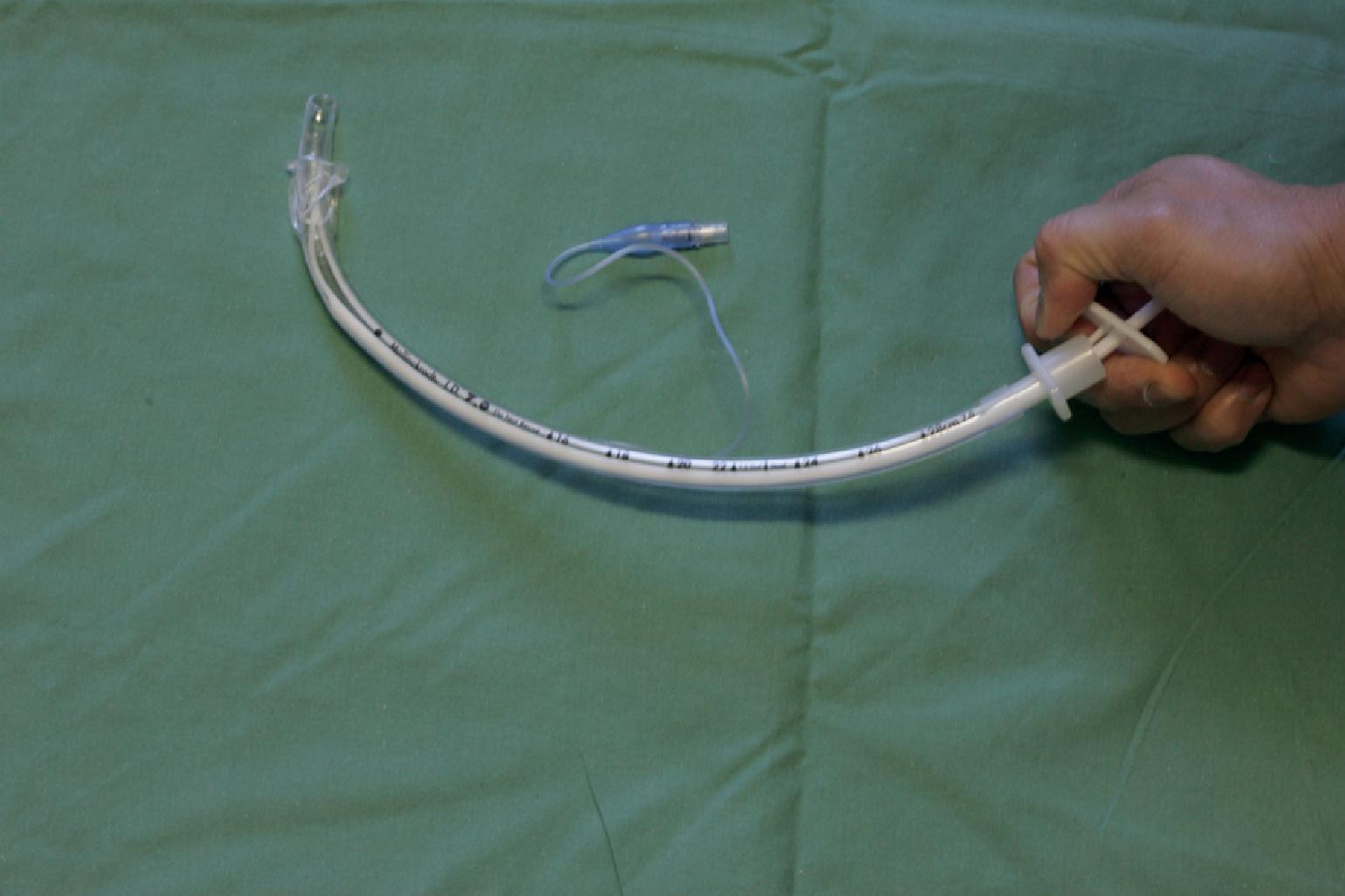
The Introes Pocket Bougie (BOMImed, Winnipeg, Manitoba, Canada) is made of Teflon and therefore requires no lubrication. The Pocket Bougie is curved and malleable with a soft, rounded tip. There has been no published data comparing this unique device with other intubating guides.
The Flexible Tip Bougie (Sharn Anesthesia Inc., Tampa, FL) is a steerable introducer that uses an innovative sliding mechanism capable of producing both anterior flexion and retroflexion. It has an atraumatic silicone tip that reduces the risk of tracheal trauma ( Fig. 22.3 ).
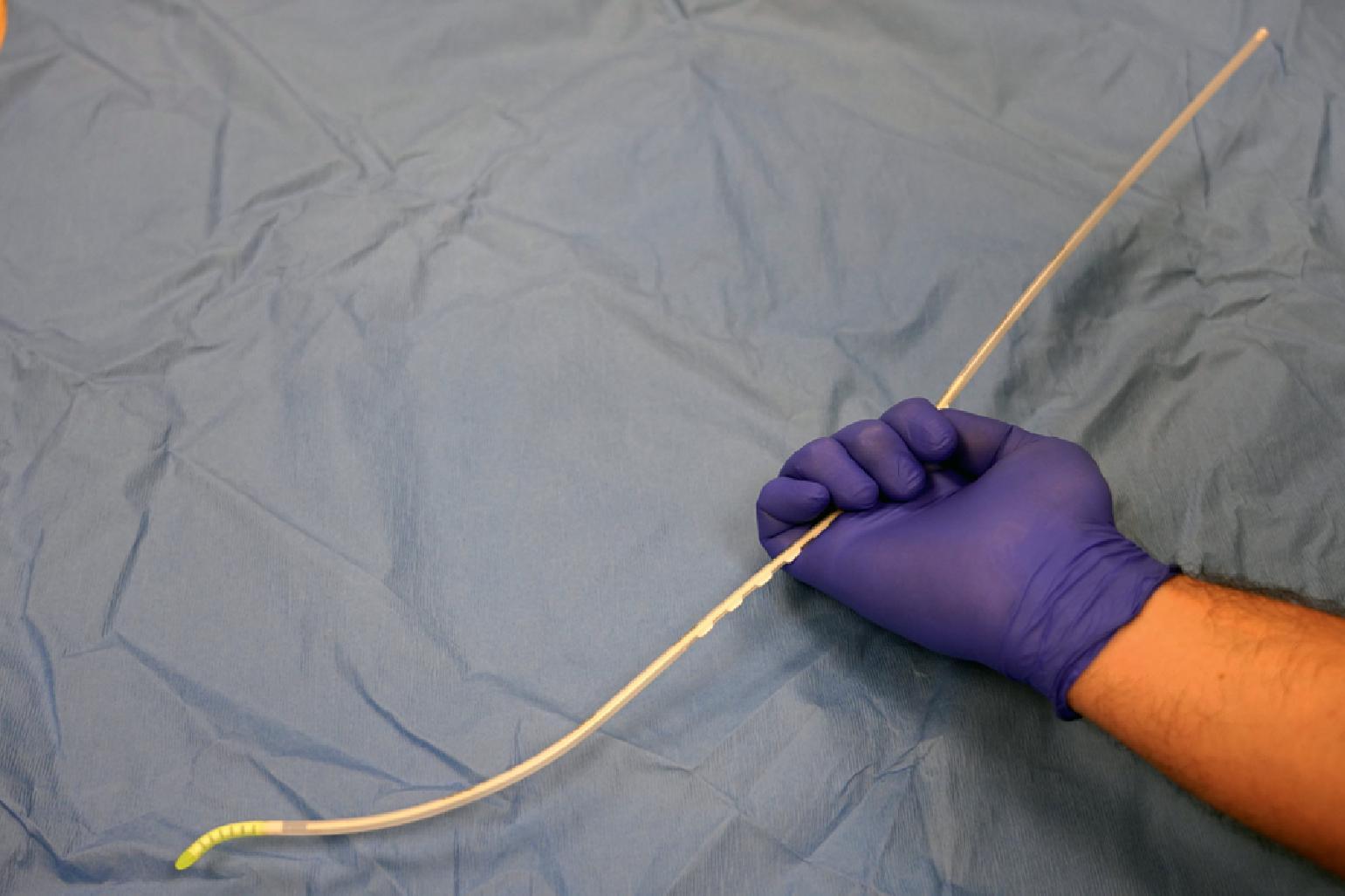
The effectiveness of intubating guides in patients with a DA has been well established. , Most of these studies, however, used the EI. With only a few exceptions, there is currently little data to support the use of the newer devices for tracheal intubation, particularly in patients with a history of DA. It should be emphasized that most of these new intubating guides and stylets are disposable and designed for single use. In contrast, the EI is more cost-effective because it is reusable.
ETT exchangers, or airway exchange catheters (AECs), are ETT guides designed to facilitate exchanging an ETT, DLT, or SGA. Although the EI can be used as an ETT exchanger, several devices have been developed specifically for this purpose.
The Cook Airway Exchange Catheter (Cook Inc., Bloomington, IN) is a hollow, flexible, straight tube designed as an ETT exchanger. It is 83-cm-long and available in 11-French, 14-French, and 19-French sizes to accommodate ETTs 4.0 mm or more, 5.0 mm, and 7.0 mm IDs, respectively. A 45-cm-long, 8-French version is available for ETTs 3.0 mm or more. The extra firm (EF) model, available in 11-French and 14-French sizes, has a soft, atraumatic tip and a stiff proximal portion that is useful for exchanging DLTs.
The Aintree Intubation Catheter (Cook Medical Inc., Bloomington, IN) is a shorter (56 cm), hollow, flexible, straight catheter designed to accommodate passage of a flexible intubation scope (FIS) with a maximum outer diameter of 4.2 mm ( Fig. 22.1F ). It can be used for uncomplicated ETT exchange or to exchange an SGA for an ETT 7.0 mm or more ID. Additionally, the Aintree Catheter can be advanced over a pediatric (11-French) AEC to provide additional stiffness to facilitate advancement of an ETT.
The Sheridan Tube Exchanger (Sheridan Catheter Corp., Oregon, NY) serves a similar function as the Cook AEC.
Many AECs are hollow and include adaptors that allow connection to an oxygenation source, such as the anesthesia circuit or jet ventilation. In a review by Duggan and colleagues, it is recommended that, should a patient decompensate with an AEC in-situ, reintubation should be the primary management strategy due to the risk of failure or barotrauma. Supplemental oxygen can be provided using standard techniques prior to tracheal intubation or between attempts, but should not be attempted through the AEC.
ETT stylets are plastic-coated metal rods that can be placed inside the lumen of an ETT before intubation to stiffen and/or preshape the ETT. Unlike the EI and other introducers, the stylet should not protrude past the tip of the ETT to avoid trauma to the airway. Water-based lubricant should be used, and easy passage of the stylet in and out of the ETT should be demonstrated before use. The best shape for a stylet-shaped ETT depends upon the clinician’s preference and the patient’s position and anatomy, as well as the type of laryngoscope used. However, Levitan has shown that the line of sight to the larynx can be improved if the stylet remains “straight-to-cuff,” at which point the ETT can be bent to the desired angle like a “hockey stick” ( Fig. 22.4 ). An angle of 35 degrees or less reduces the risk of traumatic injury. Once the ETT has passed through the vocal cords, the stylet should be withdrawn as the ETT is advanced into the trachea.
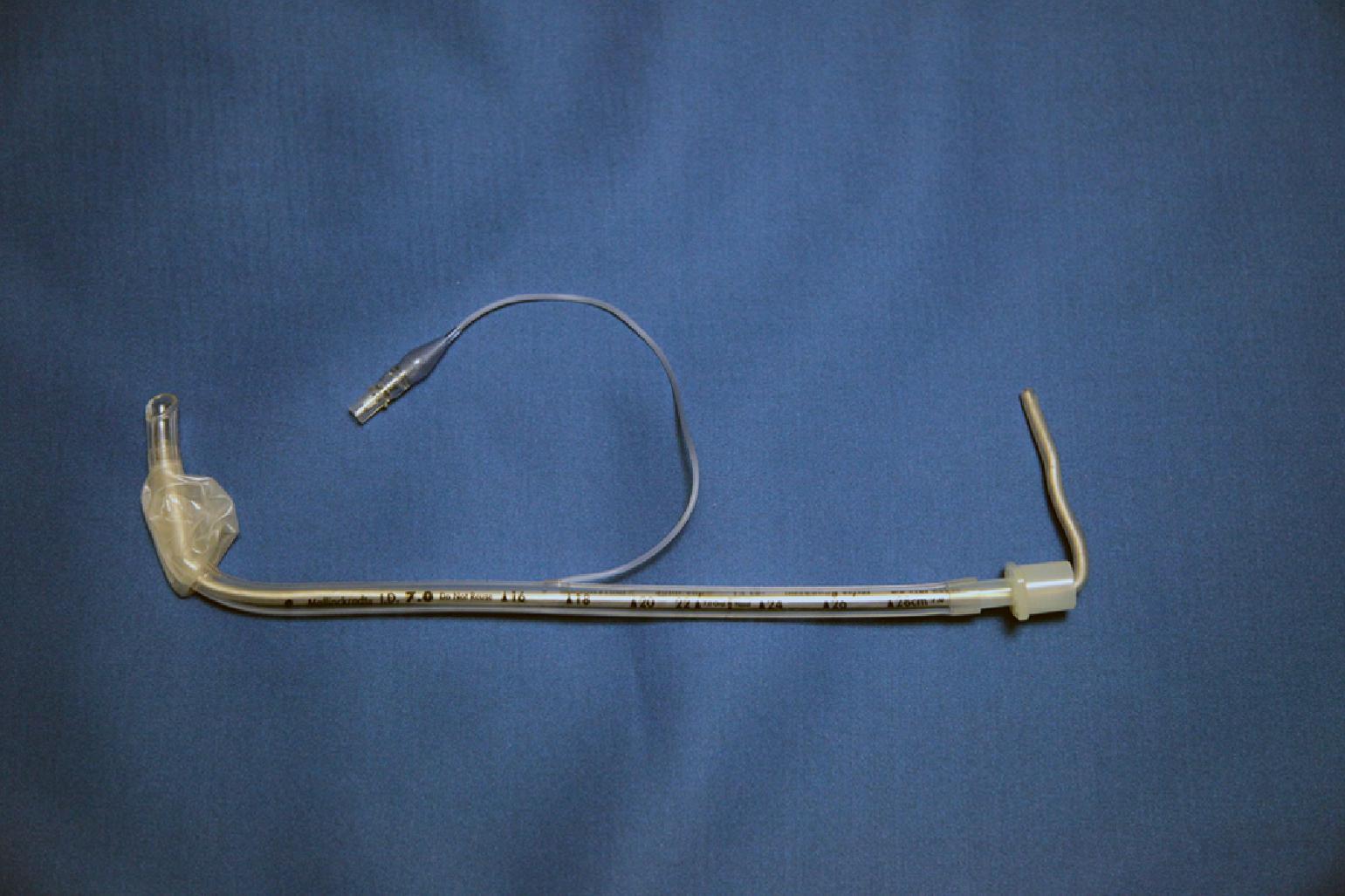
In a randomized trial, Gataure and colleagues compared the efficacy of the EI versus the malleable stylet in 100 anesthetized patients with simulated difficult (CL grade 3 view) direct laryngoscopy (DL). The EI had a success rate of 96% after two attempts, compared with 66% in the stylet group.
Video-assisted laryngoscopy (VAL) has changed the way in which patients with anticipated difficult DL are managed. Videolaryngoscopes (VLs) can be divided into those that feature classically shaped laryngoscope blades and those that feature highly curved or hyperangulated blades. Classically shaped blades feature a Macintosh-type design that allows the operator to visualize the glottis either directly or indirectly via an image displayed on the video screen. Hyperangulated VLs, such as the GlideScope (Verathon, Bothell, WA) and the C-MAC D-Blade (Karl Storz, Tuttlingen, Germany) depend on visualization of the glottis on the video screen, converting the passage of the ETT into an indirect approach. One common issue with VAL, especially when using a hyperangulated blade, is difficulty placing the ETT through the glottis despite excellent glottic visualization.
The routine use of a styletted ETT has been advocated when indirect laryngoscopy is performed with a VL. The use of a malleable stylet or bougie is usually required for the hyperangulated VLs. A nonstyletted ETT can be used for VLs with Macintosh-type blades; this is generally based on the preference of the operator. Benefits of a bougie-based technique versus a styletted ETT remain unclear.
In addition to malleable stylets, device-specific rigid stylets are available. The GlideScope manufacturer has produced a GlideScope-specific rigid stylet, the GlideRite stylet (Verathon Seattle, WA; Fig. 22.4 ). This rigid stylet is reusable, with processing required between each use. Several studies have shown conflicting results regarding time to intubation and overall success rates when comparing the GlideRite stylet with malleable stylets.
As with DL, multiple studies have been performed to determine the best angle for a styletted ETT to be used with VAL. , , Various configurations have been advocated, including a corkscrew configuration, a “hockey stick” of 90 degrees, other different angles, and a stylet angle that mimics the curvature of the VL blade.
Despite the good visualization of the glottis achievable with VAL, there is often difficulty encountered with ETT delivery. When using a hyperangulated VL, advancement of the ETT past the vocal cords may be difficult as the anteriorly directed ETT often abuts and is held up by the anterior tracheal wall. This has led to some practitioners advocating a “reverse loading” approach for preparation of the styletted ETT , or the use of a straight ETT. Because of small, mostly simulation-based studies, the ideal ETT stylet angle is not known. In agreement with previously published reports, , the authors of this chapter generally use a saline- or sterile-water-warmed, reverse-loaded, 90-degree-angled (“hockey stick”) ETT when performing VAL.
Despite widespread use, complications associated with the use of an ETT introducer, tube exchanger, or stylet are rare. Since the advent of VAL, multiple case reports have been published regarding soft tissue and pharyngeal injuries in which contribution from a styletted ETT could not be ruled out. These cases highlight the importance of vigilance and awareness of ETT location with initial placement and advancement when using an introducer or styletted ETT for VAL. Reports of trauma during airway management frequently come from cases in which multiple attempts at securing the airway have occurred and multiple devices were used, making it difficult to attribute damage to a single device. Because of the firmer material, single-use ETT introducers exert more pressure at the tip when compared with the multiuse EI ; whether this corresponds to greater risk of airway trauma remains unknown. However, as with all airway devices, excessive force should always be avoided. Holding an ETT introducer close to the coudé tip (e.g., with Magill forceps) increases the pressure exerted at the tip and is therefore not recommended.
Following tracheal intubation, all introducers and stylets should be inspected to ensure that no part of the device has been left behind. One case report describes the tip of an EI becoming detached and lodged in a patient’s airway, whereas a similar case describes how the plastic coating peeled off a stylet, blocking the ETT lumen. An unusual case report described an ETT involuting at its tip as the EI was withdrawn, thereby lodging the EI firmly within the ETT and necessitating removal of both devices. Routine generous lubrication of intubating guides should reduce the likelihood of such complications.
Intubating introducers, stylets, and tube exchangers have been used successfully to facilitate tracheal intubation for many decades. The tracheal introducer is an inexpensive, reliable, and familiar tool used by anesthesiologists and, more recently, by emergency physicians and in the prehospital setting. Although the popularity of these nonvisual intubating techniques may decrease as VAL is more frequently used, these devices may still play an important role in video-assisted intubation as a number of studies have reported the efficacy and usefulness of stylets and introducers to assist intubation using VLs. ,
Tracheal intubation using the transillumination technique was first described by Yamamura and colleagues in 1959 when they reported the use of a lighted stylet for nasotracheal intubation. Modern lighted stylets use the principle of transillumination of the soft tissues of the anterior neck to guide the tip of the ETT into the trachea. This method takes advantage of the anterior (superficial) location of the trachea relative to the esophagus. When the tip of an ETT with a lighted stylet enters the glottic opening, a well-defined circumscribed glow can be readily seen slightly below the thyroid prominence ( Fig. 22.5A ). However, if the tip of the ETT is in the esophagus, the transmitted glow is diffuse and cannot be detected easily under ambient lighting conditions ( Fig. 22.5B ). If the tip of the ETT is placed in the vallecula, the light glow is diffuse and appears slightly above the thyroid prominence. Using these landmarks and principles, the practitioner can guide the tip of the ETT easily and safely into the trachea without the use of a laryngoscope.

During the past three decades, several versions of the lighted stylet have been introduced, including the Surch-Lite (Bovie Medical Corporation, Clearwater, FL), Flexi-lum (Concept Corporation, Clearwater, FL; Fig. 22.6 ), Tube-Stat (Concept Corporation, Clearwater, FL; Fig. 22.6 ), and the Trachlight (Laerdal Medical Corp., Wappingers Falls, NY; Fig. 22.7 ). Over the years, these devices have proven to be effective and safe in placing an ETT both orally and nasally.
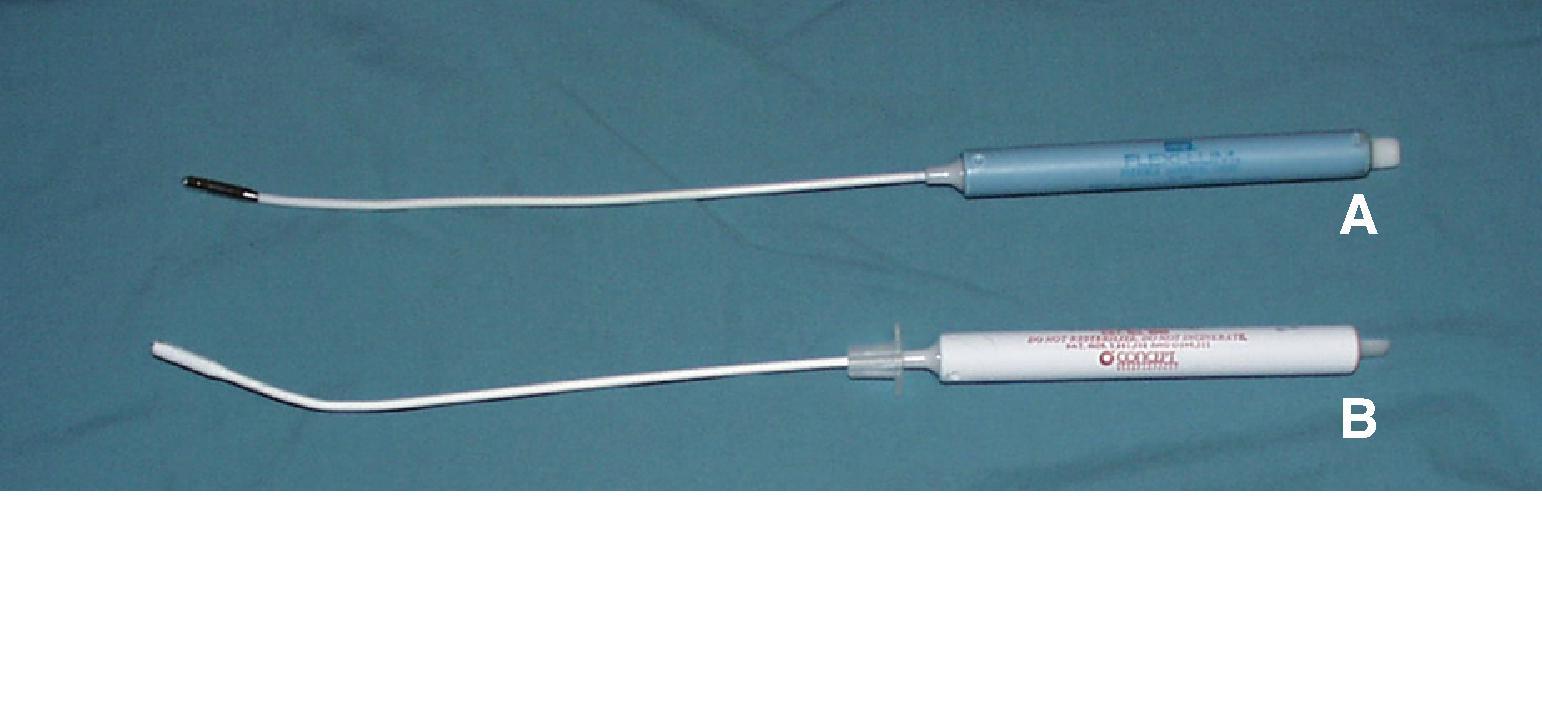
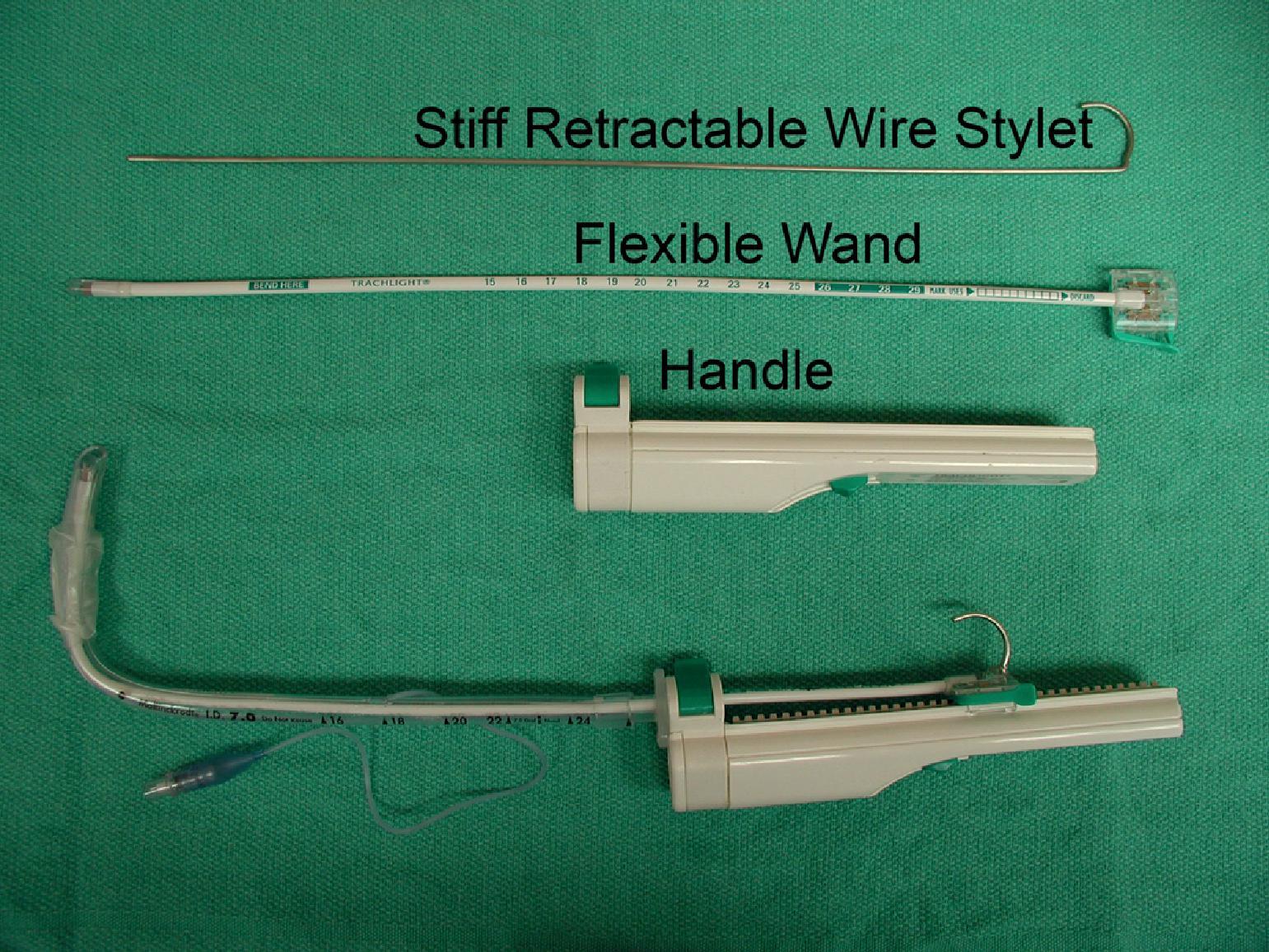
Compared with the other devices, the Trachlight has a longer and flexible wand with a retractable metal wire stylet and an improved light source. These features add flexibility, broaden the utility of the device for both oral and nasal intubation, make intubation easier, and permit the evaluation of the position of the tip of the ETT after intubation. To date, the Trachlight has been the most popular and well-studied of the lighted stylets. Although the Trachlight is no longer manufactured, a new version of the lighted stylet similar to the Trachlight is currently in development. , One of the authors of this chapter (Orlando Hung) was involved in the design and development of the Trachlight; for these reasons, much of what follows reflects this experience and bias toward the Trachlight. Nevertheless, the concept and principles of intubation using transillumination are applicable to all other lighted stylets.
For oral intubation, the lighted stylet is best used to shape the ETT into the form of a “hockey stick” (see Fig. 22.7 ). This configuration directs the bright light of the bulb against the anterior wall of the larynx and trachea. In addition, the “hockey stick” configuration enhances maneuverability during intubation and facilitates placement of the ETT through the glottic opening. However, a “hockey stick” is an awkward-shaped object to advance into the trachea. Thus, if the Trachlight is used for intubation, once the tip of the ETT-lighted stylet (ETT-LS) unit has passed through the glottic opening, the internal wire stylet should be retracted about 10 cm. This makes the distal end of the ETT-LS unit malleable and enables advancement into the trachea safely and without difficulty.
The glow emitted from the Trachlight can now be seen to migrate down the patient’s neck and may be used to confirm correct placement of the ETT. When the glow reaches the sternal notch, the tip of the ETT is located about halfway between the vocal cords and the carina. The lighted stylet is then removed, leaving the ETT in place.
Become a Clinical Tree membership for Full access and enjoy Unlimited articles
If you are a member. Log in here